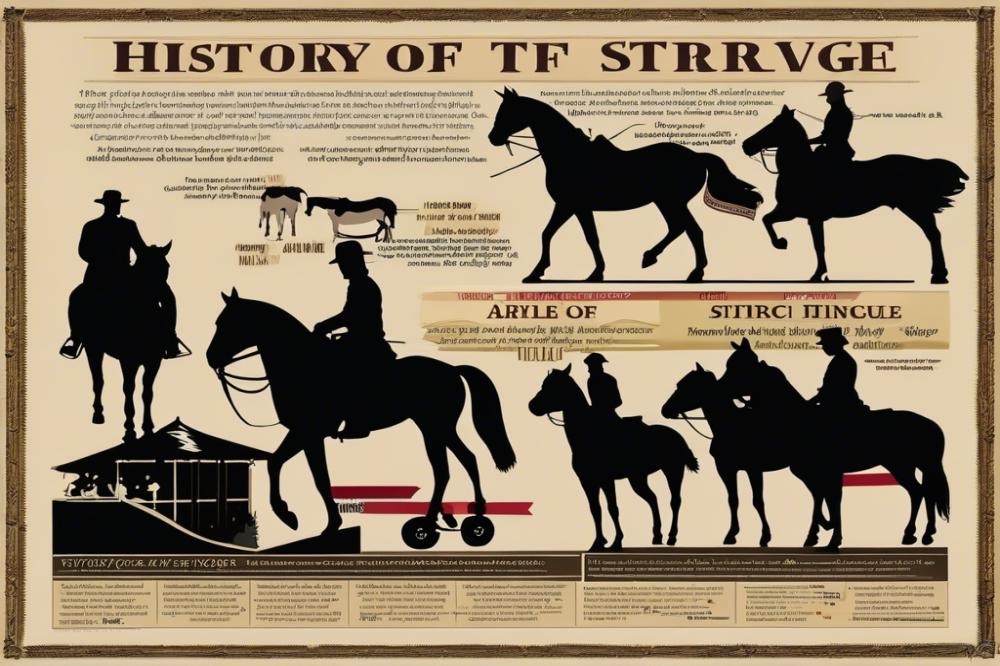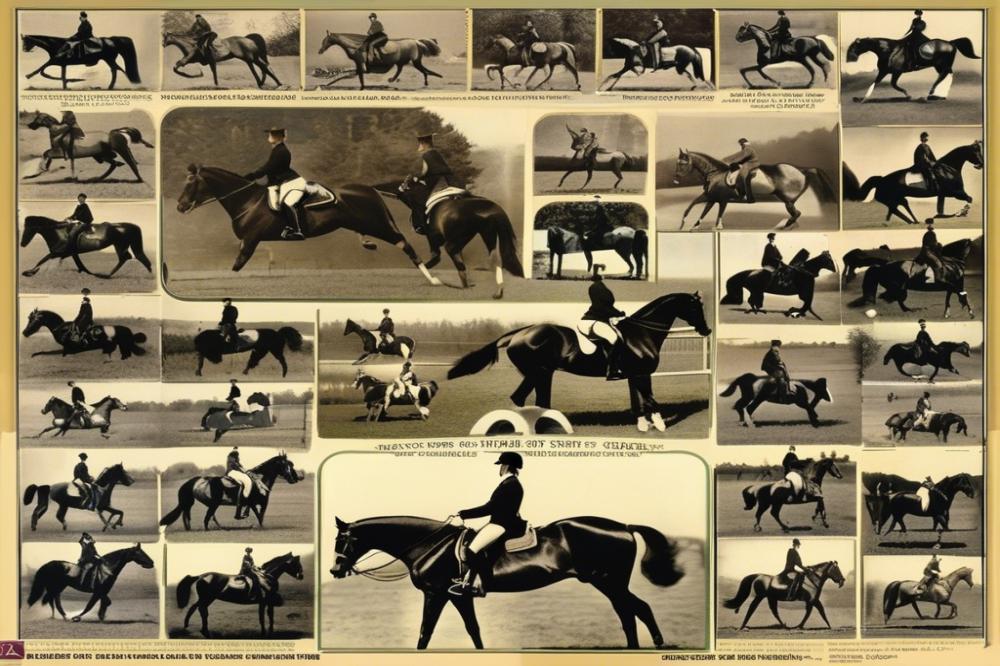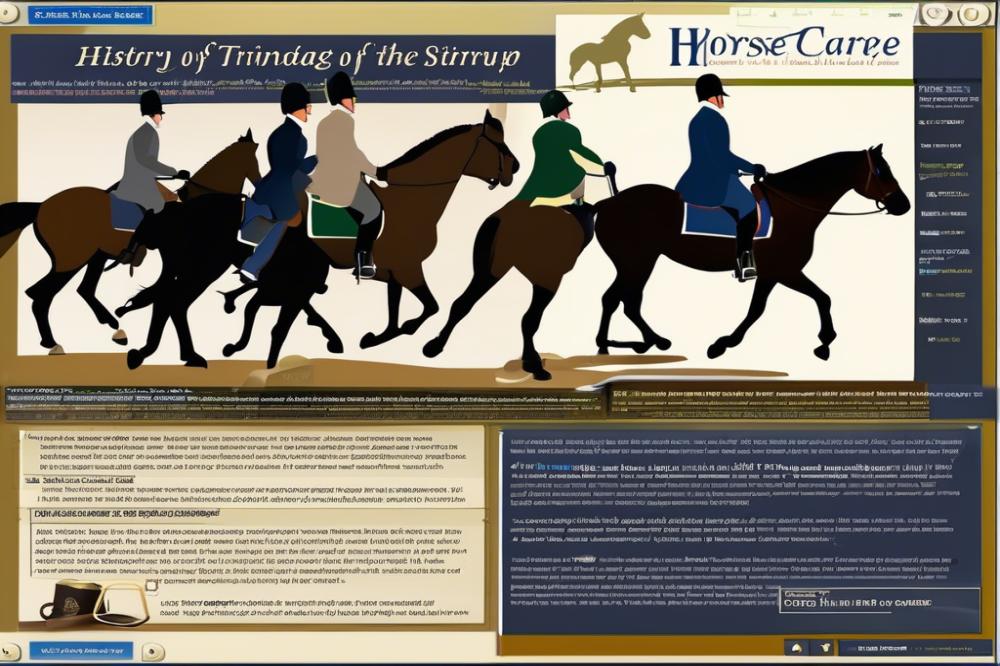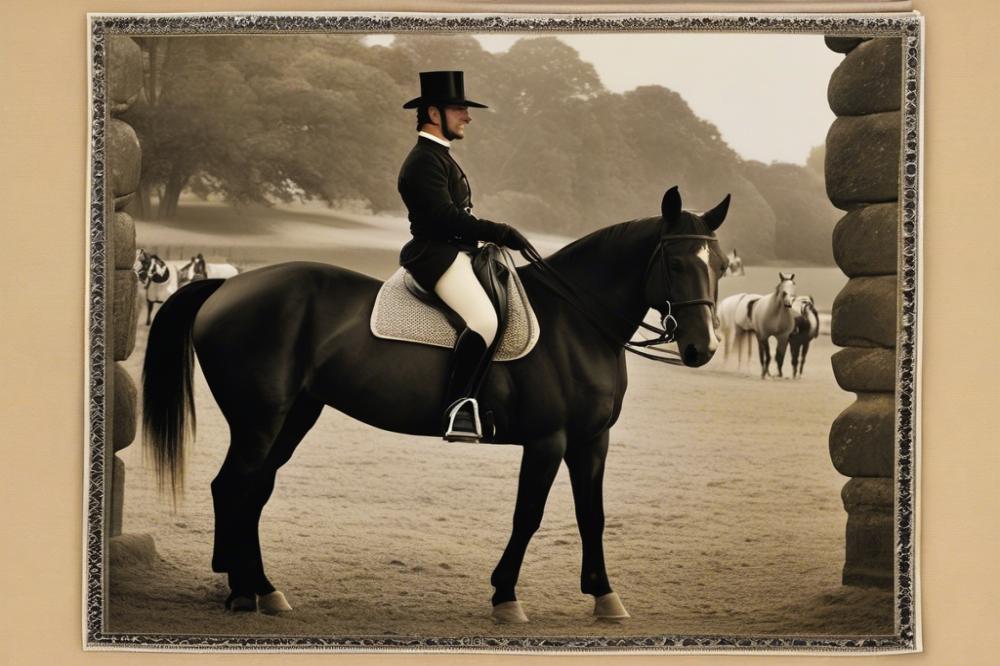Overview of the Stirrup
Have you ever thought about how something as simple as a stirrup could change the course of history? These little loops of metal or leather have played a surprisingly big role in the world of horses. They make riding much easier, allowing riders to mount and dismount with more confidence. While we often focus on horse care and management, it’s good to remember how innovations like the stirrup have developed equestrian techniques over time. Without them, we might still be bouncing around on horseback like manic peas in a pod!
Riding Techniques and Warfare Impact

When riders finally started using stirrups, they gained better stability on horseback. Imagine a knight in shining armor, charging into battle while at the same time steering their horse and wielding a sword. Sure, they had some serious skills, but stirrups allowed them to concentrate on the fight instead of worrying about falling off! This was especially important for cavalry units, where the ability to stay upright could mean the difference between victory and defeat.
Besides their significance in war, stirrups shifted how people viewed horse riding overall. Riders could use various techniques to control their steeds more effectively. More stability meant they could lean into turns and perform advanced riding maneuvers. It’s like having the best truck to haul horse trailer—having the right tools can seriously change the game!
As we look back, we can appreciate not only the stirrup’s practical use but also its social implications. Riding became a skill for nobility and commoners alike, further connecting humans and horses. You could say that it bridged the gap between camel vs horse riders. In many cultures, this revolutionized relationships with these magnificent animals.
Origins of the Stirrup

The stirrup has a fascinating history that starts thousands of years ago. Imagine early riders trying to balance on their steeds without any help from equipment. They had to rely heavily on their equestrian skills and sheer grit. It was a tough situation, to say the least. In the ancient world, being able to stay on a horse was an art form.
The earliest evidence of stirrups seems to pop up in India around the 4th century AD. Archaeologists have discovered some intriguing artifacts that suggest riders were using some form of foot support. This region likely played a significant role in developing the basic idea of the stirrup. Meanwhile, in China, they also embraced this riding equipment by the 6th century. Different cultures were discovering the same problem but coming up with unique solutions. Riders needed a way to feel more secure while galloping around.
As we look at the evolution from simple to more complex designs, the changes are quite interesting. Early stirrups were basic, often just a loop of leather or wood. A rider would slide their foot into it, hoping for a steady hold. Over the years, designs became more sophisticated. By the time the stirrup reached Europe, it had transformed into a more supportive structure, sometimes with added features like flanges to help keep the foot in place. This leap was crucial for horse care and horse management as it could change the game completely for cavalry charges.
Riders were now able to focus on steering and other equestrian techniques, rather than just hanging on for dear life. It was like putting on a seatbelt for the first time. The extra stability offered by stirrups allowed them to use swords or bows while riding. Who knew a small piece of equipment could change the dynamics of warfare and transportation?
Over the centuries, artisans crafted stirrups from various materials, including bronze, iron, and even fine leather. Each region put its own spin on the design, leading to a rich variety that reflected the local culture. With each modification, the stirrup became not just a tool but a symbol of progress in riding techniques. Understanding this evolution sheds light on how essential riding equipment can be!
The Stirrup in Ancient Civilizations

The stirrup transformed how people rode horses. This riding equipment appeared in various ancient societies, each adding their own twist. In China, the stirrup made its debut around the 4th century AD. Chinese cavalry used it to gain an edge in battles. With better stability, soldiers could wield their weapons more effectively. Equestrian skills soared as riders grew more adept. Imagine flying into a battle with a newfound sense of security beneath you!
Moving west, the Persians also adopted stirrups. By the time of the Achaemenid Empire, mounted troops became a considerable force. These stirrups allowed archers to shoot arrows accurately while riding. Horse care and horse management improved as techniques evolved. The Persian cavalry was a sight to behold, riding swiftly while holding their bows like pros.
Meanwhile, the Romans took notice of the stirrup’s potential. Their legions leveraged this new riding gear for maximum impact. With improved tactics, cavalry units could engage foes more confidently. Equestrian techniques became common knowledge among Roman leaders. Battles were no longer just about infantry. Mounted warfare shifted the entire strategy and effectiveness of armies.
Have you ever thought about how a tiny piece of equipment can change history? The stirrup gave riders better balance, enabling more aggressive fighting styles. Soldiers who previously struggled to stay mounted could now engage and defend themselves. As armies recognized its advantages, more cultures began to use it. The impact of this small invention was monumental.
While the stirrup might seem simple, its implications were vast. Each civilization that adopted it found new ways to excel in warfare. Improved riding stability meant better performance in battle. Equestrian abilities sharpened, helping soldiers ride seamlessly into action. Riding equipment began to evolve, prompting changes in tactics everywhere.
As time went on, stirrups helped create new social dynamics as well. Riders enjoyed an elevated status in society. Their equestrian skills opened up opportunities for wealth and influence. We could say the stirrup was a game-changer, but that doesn’t capture it fully. Picture knights, warriors, and generals embarking on grand adventures, all thanks to a small piece of metal!
Medieval Developments
During the Middle Ages, stirrup design saw interesting changes. New shapes and materials emerged, which transformed riding. Early wooden models evolved into more robust metal ones. Riders could now stay balanced even as they charged into battle. This stability was crucial for knights. They needed to wield swords while maintaining control of their horses.
The stirrup’s influence extended beyond mere riding. In feudal society, it became a symbol of status and power. A well-mounted knight was seen as a formidable warrior. This led to a hierarchy where rich lords had the best horses and equipment. Meanwhile, poorer knights or foot soldiers found it hard to compete. Equestrian skills took center stage in the training of young nobles.
How did this fit into the culture of chivalry? Knights not only fought for lords but also for honor. They followed a code that emphasized bravery, loyalty, and respect. Stirrups played a role in making these qualities possible. With better stability, knights performed dazzling maneuvers. The art of combat grew more complex. Jousting became a popular sport, showcasing both riding equipment and knightly valor.
Horse care, horse management, and equestrian techniques became essential knowledge. Knights learned to bond with their steeds, which was key to success in war. Riders had to understand their horses on a profound level. Manuals or a stirrup guide were sometimes even used to share these secrets. Such wisdom helped ensure riders knew how to handle different situations.
While it all sounds pretty glamorous, it wasn’t just riding into battle. Life as a knight included training and maintenance of your mount. Horses needed grooming and feeding, just like a best friend. Sure, the ability to charge into combat was impressive, but the connection developed with the horse mattered too. Riders built a partnership that was essential for both. Trust between knight and steed was vital for survival.
Renaissance and Beyond
The Renaissance sparked a wave of creativity and innovation that touched many fields, including horse riding. As artists and thinkers began to explore new ideas, designs for riding equipment also evolved. Stirrups became more than just tools; they reflected the artistry of the time. Imagine a craftsman shaping metal with the finesse of a painter wielding a brush. That’s how important changes began to take shape!
Art influenced the design of stirrups in interesting ways. Designers paid attention to both function and beauty. During this time, the stirrup was often adorned with intricate patterns and delicate embellishments. Wealthy riders wanted their equipment to showcase their status and taste. Equestrian skills were now paired with unique aesthetics.
Horse care and horse management were also changing. Riders needed stirrups that were reliable and effective. With the rise of equestrian sports in Europe, it was crucial for stirrups to become more standardized. This standardization ensured that riders could focus on improving their equestrian techniques instead of worrying about whether their gear would hold up.
Simply put, riders of the era understood that a strong connection with their horse mattered. Stirrups made that connection better. The right stirrup helped maintain balance and control during competitions. As a result, riders could develop their abilities with greater confidence. Such attention to detail revolutionized riding and influenced how horses were managed and cared for.
By the time stirrups became a common part of riding equipment, they were no longer just practical tools. They represented a blending of culture and sport. The excitement of tournaments led to an increase in popularity for beautifully crafted stirrups. In many ways, they became symbols of prestige, much like a trophy hanging in an athlete’s home.
Artisans began to create stirrups for specific disciplines, such as jumping or dressage. This specialization guided riders in selecting the best equipment for their needs. It was like having a stirrup guide that tailored their riding experience. No longer were riders limited to one type of stirrup. Choices blossomed everywhere!
As time went on, the designs continued to evolve. Functionality was key, but style never took a back seat. This evolving relationship between utility and aesthetics brought forth new materials and construction techniques. What started as simple tools became sophisticated pieces of equipment. Riders were now equipped to showcase their skills while still looking fashionable.
Modern Stirrup Designs
In today’s world, stirrups have come a long way. Riders are now greeted with a variety of modern stirrup types. Some are made from materials like aluminum, carbon fiber, and even plastic. These materials are often lighter than traditional iron. The goal? To improve performance and comfort while riding.
When comparing modern stirrups to the classic designs, differences become clear. Traditional stirrups were generally simpler. They focused on basic function without much thought about comfort or safety. Nowadays, many stirrups include features that support equestrian skills, making them more user-friendly. Some even have a flexible design allowing for a better foot position. That’s not something you’d find in the old days!
Safety Features
Modern designs pay careful attention to safety features. Some stirrups have quick-release mechanisms. If a rider falls, the foot can slip out easily. This reduces the risk of being dragged or getting stuck. That’s a real game changer for riding equipment!
Another innovative feature is the anti-slip grip. Riders can have peace of mind knowing their boot won’t slide out during a critical moment. Plus, many stirrups now come with a wider base. This design aids in managing balance and provides better support as riders work on their skills.
Ergonomics in Stirrup Design
Ergonomics is another aspect that modern stirrups tackle impressively. Comfort matters during long rides. Many designs are created with the rider’s anatomy in mind. For instance, the angle and position of the stirrups can help reduce strain on knees and hips. This thoughtful approach helps riders focus more on their equestrian techniques instead of discomfort.
Some riders even swear by shock-absorbing models. These can lessen the impact when moving over rough terrain. Imagine riding along a bumpy trail, and instead of feeling every jarring motion, you glide smoothly. Who wouldn’t want that?
All this innovation doesn’t mean the basic function of the stirrup gets overlooked. Each design works to fulfill its purpose while adding modern perks. With all these options, there’s something for every type of rider, regardless of their skills.
For anyone interested in horse care, choosing the right stirrups is essential. Riders have become increasingly aware of how important proper equipment is for both themselves and their horses. A well-chosen stirrup plays a pivotal role in successful riding.
The Stirrup in Equestrian Sports
The stirrup has played a big part in several equestrian disciplines. It helps riders stay balanced while showcased their equestrian skills. Without it, riding would become quite tricky, especially in events that need precision and speed. Think about how it feels to ride with or without them. You’d likely prefer the support of those little metal or leather loops!
Dressage, a highlight of equestrian competition, showcases the beauty of horse and rider working together. Stirrups help maintain good posture and control. Riders need to demonstrate grace, and the right stirrups make that achievable. They allow for subtle movements and shifts that communicate effectively with the horse.
In show jumping, riders often take on a unique challenge. Speed and agility are key, and those stirrups help riders stay secure while leaping over fences. Imagine trying to fly through the air without something to hold onto! A solid grip helps in landing and preparing for the next jump. It’s a dance between rider and horse, facilitated by excellent riding equipment.
Other sports, like eventing or rodeo, also rely heavily on the stirrup’s design. In eventing, riders gallop through challenging courses filled with jumps and obstacles. Here, a sturdy stirrup provides stability during wild gallops. Rodeo riders, on the other hand, need a whole different kind of support. They engage in activities that demand fast reflexes. A strong hold on the stirrups is essential, especially while trying to stay on a bucking bull!
Learning proper horse care, horse management, and how to use stirrups effectively is critical for success in equestrian sports. New riders often benefit from a good stirrup guide. It helps them understand the best practices for positioning their feet and maintaining balance. Good foot placement can make a world of difference.
As you can see, stirrups aren’t just simple pieces of equipment. They’re vital in shaping riding styles and boosting performance across various equestrian techniques. Understanding their role can lead to a more enjoyable and successful riding experience. So, next time you see a rider in action, remember the stirrup’s journey and its importance across many equestrian events!
Closing Thoughts on the Journey of the Stirrup
Looking back at the history of the stirrup, it’s clear that this simple piece of equipment has played a monumental role in shaping how humans interact with horses. It’s mind-boggling to think that what began as a basic tool has evolved into a cornerstone of equestrianism. Riders of all kinds—from knights charging into battle to cowboys herding cattle—have benefited from this handy invention. The stirrup has made riding safer and more comfortable, allowing people to climb atop their trusty steeds with confidence.
Why is this significant? Well, imagine trying to ride a horse without them. It’s like trying to swim upstream without any arms; quite the challenge! Stirrups provide stability and support, giving riders a firmer grip on their mounts. Horses, in return, are often more responsive and easier to manage. A little less horse crow hopping and a bit more smooth riding goes a long way in creating harmony between rider and horse.
Reflecting on how horseback riding has transformed through the ages, it’s evident that stirrups have not merely been accessories; they’ve been game-changers. As civilizations advanced, so too did the designs and materials used. From leather and wood to metal and synthetic fibers, innovations have come and gone, each improving the way we ride. However, one question persists—do horses need water? Absolutely! But let’s leave that for another conversation.
As we peer into the future, it’s fascinating to ponder how stirrups will continue to evolve. Advances in technology could bring us smart stirrups that track performance or adjustable ones that cater to each rider’s needs. Historically, change has always been present, and who knows what unique developments lie ahead?
In conclusion, the humble stirrup has played a pivotal role in our long-standing romance with horses. They’ve not only enhanced safety and riding efficiency but also deepened the bond between human and animal. Whether you’re casually riding in a field or competing in an arena, the stirrup is there, quietly supporting your journey—without making a fuss. So, the next time you hop on a horse, take a moment to appreciate that little device that holds so much history and continues to shape our adventures on horseback.



